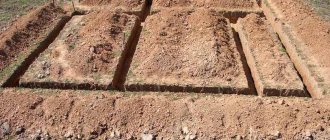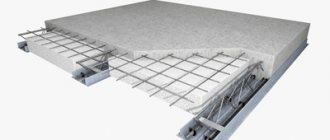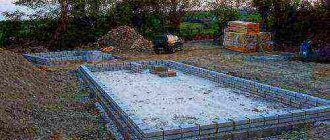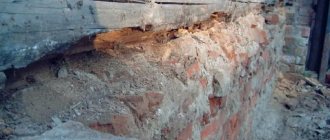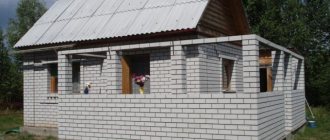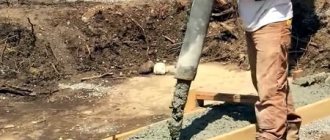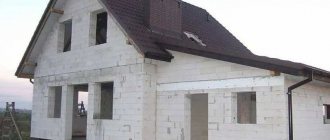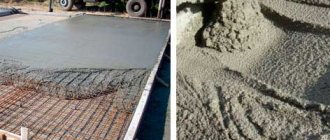With the advent of such building material as foam block, it became possible to quickly build light and warm houses up to 2 floors high.
Due to the small specific gravity of the wall masonry, builders strive to minimize the load from the weight of the building per unit area of the soil foundation. This in turn affects the calculation of the optimal foundation depth.
Qualitative assessment of the soil on the site selected for construction.
Before building any house, dacha, cottage, the area is first studied. What kind of soil, the composition of the earth, is there groundwater underground, are there various communications, cables, etc. running under the site. The composition of the soil is studied at a depth of 2.5 - 3 m. To do this, it is necessary to create a detailed analysis of the soil layers. Since ordinary people have little experience in such matters, and one can easily confuse slightly heaving soil with non-heaving or mixed soil, it is advisable to make an application to professional specialists, to certain services. As soon as the soil is ready, you can begin choosing a foundation.
How to make the most reliable foundation with your own hands for a house made of foam blocks, reliably, quickly and inexpensively? First, you need to make a design for your future home. To do this, you need to calculate in advance the weight of the building, determine the type of soil, decide how many floors there will be in the house, and whether there will be a basement.
- Shovel.
- Concrete mixer.
- Roulette.
- Hammer.
- Buckets
- Level - ruler.
- Drill.
- Screwdriver.
- Hammer - pickaxe.
- Screwdriver.
- Cord, rope, metal wire.
- Screws.
- Chisel.
Adviсe
The construction of a foam block house must begin with the design and selection of the type of foundation, on which the strength and service life of the structure will depend. If laying the foundation is carried out independently, then novice craftsmen will be helped in this by the advice of experienced specialists.
Before installing the foundation, you should definitely examine the soil of the site. To do this, a well 2.5 m deep is first dug, soil samples are taken and their composition is determined. Depending on this, the type of foundation is determined
For areas with weak soil, it is best to choose a strip foundation. Great attention should be paid to the depth of soil freezing; as a rule, it ranges from 1 to 2 m.
- For areas where the groundwater level is close to the soil, it is advisable to construct monolithic slabs. This will be the cheapest option, since when laying a strip base, you will additionally need to install a drainage system and waterproofing, which will entail significant costs for the purchase of material and will slow down the construction process.
- The foundation design must be drawn up taking into account additional extensions to the house, as well as the presence or absence of a basement. Most country houses have basements in their layout, so for them it is necessary to choose strip foundations and worry about quality drainage.
- If you need to install a foundation quickly and inexpensively, then the best choice would be a pile foundation; monolithic slabs are considered expensive, so their installation will require a lot of expense.
- Laying the foundation for a foam block house can be done either with the help of specialists or independently. At the same time, the latter option will allow you to save money and individually plan the stage of work. In order to install the foundation with your own hands, you do not need to have special skills; it is enough to correctly prepare the project and calculate all the parameters. Thanks to simple formulas, you can quickly calculate material consumption and slowly complete a high-quality installation.
To learn how to build a house from foam blocks with your own hands, see the following video.
All types of foundations for houses made of foam blocks.
Columnar foundation, suitable for heaving and clayey soils. Typically, one-story buildings are installed on such a foundation. Formation of the foundation in the ground, pillars are dug to a certain depth. For structural strength, reinforcement is laid in the form of a frame. Then the whole thing is filled with concrete mixture.
How wide should the foundation be?
A pile, screw foundation is erected if the house is planned to be built on a hill or its slope. This foundation is suitable for soft, loose, unstable soils. Each pile must have a recess of 4 to 6 meters as a minimum.
To do this, metal piles are screwed into the soil. A concrete monolithic beam – tape – is required to be installed on top, for greater reliability. Reinforcement is laid on top of it. And only then the foundation is poured. A pile foundation is also made from hanging piles and rack piles. The process of forming a foundation is the same as for a screw pile.
A monolithic foundation, also popularly called “slab”, is suitable for all types of soil. Since the concrete slab can move with the soil. This type of foundation is not recommended for clay soils.
Formation of the foundation.
In order to make a monolithic foundation yourself, you must first dig a foundation pit at least 60 cm deep. Then a “cushion” is poured into it, and waterproofing is laid on top. Only after this the reinforcement is laid in several layers, after which the entire structure is filled with concrete.
Strip foundation, suitable for heaving and clayey soils. It is formed from a continuous ribbon of reinforced concrete along the perimeter of the load-bearing walls of the house. The main principle of such a foundation is that the foundation of the house should not only be well stable and reliable, but also light. There are two types of strip foundations: recessed and slightly damaged.
A buried foundation is made as follows: the foundation is laid to a sufficient depth so that the soil does not freeze. It should be remembered that such a foundation should be wider than the walls of the house themselves, by about 100 mm, on all sides. The base of the building must have a minimum of 40 centimeters. After building the base, the reinforcement is laid in two rows, two layers each. However, this type of foundation has its drawbacks.
Firstly, the entire process of forming the foundation takes too much time and effort. Secondly, you must immediately have a certain amount of money so that there is enough for all the building materials that should be purchased in advance. Thirdly, you cannot build such a foundation yourself; you need assistants or a construction team, and their work must also be paid.
Typically, such a foundation is laid during the construction of multi-story buildings, or 3-story mansions with a basement. If, according to the project, the house has a basement, then such a foundation is better than other types.
A slightly damaged version of the foundation, much simpler than the previous one. And it differs from it in that it is suitable for one-story buildings and is laid at shallow soil depths. This type of foundation is low-cost, and even a beginner in the construction business can lay it. The most important thing here is to maintain all the necessary proportions.
So, to begin with, you can use an ordinary shovel; you need to dig a trench yourself, 60 cm deep. Then pour a “cushion” consisting of sand with crushed stone (gravel) into it. You should fill it in even layers of 15 cm each, preferably several times. Now we make the formwork and fill it all with concrete.
Now we make a frame of reinforcement in the upper part of the base and secure it securely. The width of the base should be 10 cm wider than all the walls in the house. A shallow foundation is ideal for non-heaving, hard layers of earth.
Material characteristics
Foam blocks are relatively lightweight materials
Foam concrete blocks (foam blocks) differ from traditional building materials used for masonry walls in their manufacturing technology and in a number of positive qualities unique to them.
Manufacturing technology
According to the existing classification, foam concrete is included in the category of cellular concrete. During its production, some kind of foaming agent is introduced into the sand-cement mixture. The latter is obtained using rosin, bone or flesh glue, caustic soda, etc. as the main material.
In addition to substances of natural origin, synthetic substances can be used as a foaming agent. However, blocks made from such foam concrete have questionable characteristics and can be harmful to human health.
In the production of foam concrete the following is used:
- fine river sand without clay impurities, the humidity of which should not exceed 5%, quartz content of at least 75%;
- Portland cement, the brand of which determines the density of the resulting blocks (M-400, M-600, D-400, etc.);
- soft purified water;
- foaming agent PB-2000, SDO-M, etc.
Sometimes VSM fiber fiber is added to cement, which makes it possible to increase the compressive strength of foam blocks by 25%, and fly ash, which saves up to 1/3 of the amount of cement in the mixture.
Theoretically, the technological process for manufacturing foam blocks consists of the following operations:
- mixing components;
- introduction of foam concentrate;
- pouring the resulting concrete mixture into prepared forms;
- keeping the mixture in molds until the required strength is achieved;
- quality control of finished blocks.
As a rule, foam concrete blocks are manufactured in industrial conditions and have all the necessary quality certificates confirming their technical characteristics. However, if necessary, their production can be easily organized on a site allocated for the construction of a country house.
Advantages
Foam blocks are widely used in the construction of low-rise country houses due to the following advantages:
- The high strength of foam concrete makes it possible to easily build 3-story houses from blocks.
- The low density of foam concrete, comparable to the density of wood, does not place high loads on the foundation of the building.
- The low thermal conductivity of foam concrete retains heat well in the house even without additional thermal insulation of the walls.
- The porous structure of foam concrete blocks has excellent soundproofing properties.
Foam concrete blocks have high fire-resistant properties even when exposed to open fire.
Flaws
Foam concrete blocks are not without their disadvantages:
- The low bending strength, together with the relative fragility of the blocks, requires the laying of a rigid foundation when constructing walls.
- The high vapor permeability and water absorption of foam concrete blocks makes it necessary to protect the walls with an additional layer of waterproofing. When finishing the walls you will have to use special materials.
Design of structures and loads.
How wide should the foundation for the foam block be?
Depending on the design of the house, the foundation must support the weight of the entire structure. To do this, both the project itself and the area on which it is planned to be built are thoroughly studied.
For example, if there is groundwater, a columnar or pile foundation should be installed, based on reinforced concrete monolithic slabs.
The strip type of foundation is not suitable here. And remember, no matter what foundation you choose for your future home, it must be strong and reliable.
For a columnar foundation, the pillars should be located 2 meters apart from each other. They should be located at all corners of the house, and all places in the house that will subsequently have maximum load, as well as under all load-bearing walls in the house. The more pillars are installed, the more securely your house will stand.
Instructions
Dear users! Please pay attention to the units of measurement in the calculator fields. A universal calculator for calculating foam blocks for building a house allows you to obtain the most accurate but approximate amount of materials
Remember, the more fields you fill in the calculator, the more accurate the result will be.
A universal calculator for calculating foam blocks for building a house allows you to obtain the most accurate but approximate amount of materials. Remember, the more fields you fill in the calculator, the more accurate the result will be.
Block characteristics
- Size. Select the size of foam concrete block you want to use.
- Density. Depending on the function performed (load-bearing wall, partition), it is necessary to select the correct density of the block.
- Price. You can immediately select the cost of the product in order to understand how much the building frame will cost (optional).
- Stock To avoid unforeseen situations, it is better to protect yourself and purchase a small reserve - 5% will be more than enough.
Wall parameters
- Length. The total length of all walls or the length of one wall.
- Height. Estimated ceiling height.
- Type of solution. Polyurethane foam (1 mm) or glue (2 mm).
- Masonry mesh. Many manufacturers do not recommend using masonry mesh, since, according to them, the material is strong enough and does not need additional reinforcement. However, experienced specialists have a different opinion and suggest reinforcing the masonry every 3-4 rows.
Additional options
If you need an approximate calculation of the foam block only based on the “box” of the building, you can skip the paragraph and immediately click on the “Calculate” button. For more accurate results, you need to continue filling out the interface blocks.
- Window. Specify the width and height of the window opening, then add their number. If you have many different windows, then for each individual type you need to add a separate field.
- Doors. Similarly, specify the parameters of the openings.
- Pediments. Three types of construction for different types of roofs.
- Jumpers. Fill in the characteristics of the jumpers and their quantity.
- Armobelt. A monolithic closed belt that is laid on top of the blocks.
Result
If you have filled out all the fields of the foam block calculator, the following results will be available to you at the output:
Blocks:
- Volume of one block.
- Price of one block.
- Number of blocks in 1 m3.
- Price for 1 m3 of blocks.
- Total volume of blocks.
- Total number of blocks.
- Total mass of blocks.
- Total price for all blocks.
Solution:
- Volume of solution.
- Mass of solution.
- Equivalent in container.
A number of other similar parameters will be presented for all design elements that were used by the user.
Foundation waterproofing.
To waterproof the foundation, you should only have good, high-quality material. It must be laid on the base of the foundation surface. Waterproofing can be both vertical and horizontal. The dryness in the basement and in the house depends on how correctly and efficiently the waterproofing of the foundation is done.
For waterproofing you will need: sand, clay, polymer compounds, roofing felt, geotextiles, any fine drainage.
If a basement is planned for the house, it is advisable to immediately carry out thermal insulation work along with waterproofing.
Conclusion
In the video presented in this article you will find additional information on this topic. At the same time, using this material, we can draw conclusions that not all types of foundations are suitable for use in structures made of foam concrete blocks. This is largely due to their individual properties, installation principle and soil type.
However, it is foam concrete that currently occupies a leading position in modern construction. He has proven himself well in the past, and there will be a place for him in the future.
Properties of a foam block house.
- It is being built very quickly.
- Minimum financial costs.
- Good sound insulation.
- Comfortable stay.
- Environmentally friendly material.
How wide should the foundation for a house be?
Approximate dimensions for building a DIY foundation for a house made of foam blocks, as well as the necessary tools.
- Foam blocks – 600 x 300 x 200 mm.
- Foundation bases 6 t. X 6 t. Mm.
- Foundation height – 700 mm.
- Underground foundation – 400 mm.
- Sand layer – 200 mm.
- The crushed stone layer is 200 mm.
- Concrete M 400; Concrete M 200.
Backfill depth for a one-story building.
Having set up several mines, we check after 24 hours whether there is any water in it. If it’s dry, you can look at the depth of the dense soil. When drilling with a change in soil layer (determined visually), measure the depth with a tape measure. It is better to make holes along the entire perimeter of the site, drawing up a map of the occurrence of load-bearing soil.
When checking, use a drill diameter of 200−250 mm. By drawing a preliminary sketch, you will have an idea of where and how much to dig. You will have to take into account several more important factors, the level of freezing and the depth of the bearing layer of the earth. This is also relevant for one-story and two-story houses made of any material, not just foam blocks.
What kind of foundation is needed for a house made of foam blocks?
In the process of building a house, every stage is important. This statement takes on particular significance when it comes to the foundation. It is the foundation laid for the future building that is one of the most important elements of the overall design. The foundation must take over and compensate for all the negative factors that are concentrated in the soil, and become a reliable base for the construction of the building.
How wide should the foundation of the house be?
One should not think that lightweight wall materials, which include foam concrete, do not require special attention. A house made of foam blocks has specific characteristics, such as fragility, and they cannot be ignored. Therefore, the foundation base for such a structure must provide a perfectly level base. But due to the fact that the recommended height of a foam block house is no more than 3 floors, and cellular concrete itself is a lightweight wall material, there is no need to weigh down the foundation. This will have a positive impact on the overall construction cost.
Experts highlight the following as the best options for a house made of foam blocks:
- tape (depth depends on soil characteristics);
- columnar;
- monolithic slab.
The pile type of foundation is rarely used.
Features of foam concrete
Before deciding which foundation is best for a house made of foam blocks, you should familiarize yourself with the operational features of this material. Foam concrete, like ordinary concrete mortar, consists of the following components: cement, sand and gravel mixture and water.
But unlike simple concrete, its composition for foam blocks includes a special reagent - a foaming agent. With its help, when making a mixture, it is filled with gas bubbles. This gives the cast foam blocks porosity, making them less dense and massive.
On the one hand, this makes foam block walls less durable compared to brick or cast monolithic reinforced concrete, but on the other hand, their low density provides a lot of advantages.
pros
The main advantages of foam concrete include:
- Large block sizes can significantly reduce the overall construction time. In this case, masonry of walls can be done many times faster than with the same brick.
- The porosity of the material does not interfere with free gas exchange indoors, which makes it possible to make the microclimate in the house as comfortable as possible.
- The cost per cubic meter of foam blocks is lower than the cost of brick or monolithic reinforced concrete. This allows you to build a house much cheaper than using other materials.
- High levels of thermal insulation and noise absorption make it possible to save on expensive insulation materials.
- The low weight of the material allows the use of a lightweight foundation for a house made of foam blocks. Provided there is strong soil on a light foundation, it can be used for a small country house, or you can build a two-story residential building on it.
Due to the relative lightness of foam block buildings, it is not economically feasible to arrange massive foundations for their construction. This will lead to an increase in construction time and the estimated cost of construction.
Minuses
Among the disadvantages, as already mentioned, the most important is the low strength of the material. As a result, special requirements are imposed on the foundation for a house made of foam blocks. The foundation for the foam block must be very stable.
The slightest deformation and seasonal movement of the foundation can cause cracking of foam concrete walls. This should be taken into account when choosing a foundation for a house made of foam blocks.
Another disadvantage of the material is its hygroscopicity, that is, the ability to absorb moisture. For this reason, it is impossible to construct a foundation made of aerated concrete.
The porous material will absorb moisture, and when cold weather sets in, it will cause the material to crack. As a result, a building with a foam concrete base may collapse.
Choosing a foundation for a house made of foam concrete blocks.
In order to correctly determine the appropriate type of foundation base, you need to take into account the following parameters:
- soil characteristics;
- number of storeys;
- climatic conditions;
- construction time;
- financial opportunities.
The decisive factor influencing the choice of an individual developer is the soil on the site. It is advisable to analyze the soil for its type and chemical composition. It is also necessary to determine the level of freezing in winter and the location of groundwater. Without these studies there is no point in starting construction.
Of course, the price for the services of organizations conducting soil analysis will cost a pretty penny, but in problem areas it is better to pay the specified amount and build the correct foundation than to then constantly spend money on major repairs.
How wide should the foundation for the foam block be?
What does the soil hide?
- Close location of groundwater.
- Flowability.
- Difficult terrain.
- Water saturation (“wet” soil).
In each of the above cases, a balanced approach is needed. You cannot rely on the experience of neighbors on the site, because even 20 m between buildings is a decent distance, and the soil may have completely different characteristics. When starting construction, the owner must personally conduct research on which foundation is best for a house made of foam blocks. To do this, one or two wells are drilled to a depth of 2 m exactly on the site where the house will be located. Soil samples are taken every 20-25 cm.
What width should the strip foundation be?
The relationship between soil type and foundation type.
On non-heaving (slightly heaving) soils, where the freezing depth does not exceed 1 m, and groundwater is below 2 m underground, a shallow strip-type foundation is selected and installed. If the water is located higher, then there is a need for drainage measures, which significantly increases the cost of the foundation.
It is known that the belt type loses a percentage of reliability in direct proportion to the groundwater level. If the indicator is only 0.5 m, then a foam block house will need a foundation in the form of an unburdened reinforced concrete slab. This design resists heaving and soil heterogeneity and evenly distributes the loads from a building of 2-3 floors onto the ground. The slab foundation protects the walls from cracks and the openings from deformation. A popular modern option is the Swedish stove. This is an insulated type of base, designed specifically for foam concrete blocks. The warranty period is 100 years.
A house on clay soil requires a columnar foundation underneath. A similar type is needed on peat-type soils and loams. If the non-heaving layers lie deep (2 m or more) or the area has complex terrain, a pile foundation will be required. The piles are mounted at intervals of 1 m, then it is necessary to perform a good monolithic piping. Pile foundations are installed for small buildings. Mostly these are one-story cottages, less often – houses with two floors. A foundation on screw piles is quite expensive compared to a traditional strip foundation, but in some situations you cannot do without it.
Pile grillage foundation for a foam block house.
Factors influencing choice
The depth of laying the foundation for a two-story house made of foam blocks depends on the level of groundwater in relation to the soil surface.
The level of such waters is determined by special studies. In order to save money, you can check this information with your neighbors, who will tell you with what frequency and intensity their basements and plots are flooded with water.
The freezing point of the soil composition also matters, the depth of which varies from fifty centimeters to two meters. This factor has a direct impact on the choice of the depth level of the foundation for a two-story foam block house, but most often its influence is indirect, and the manifestation indicator is determined by the characteristics of the soil composition. If the soil is not heaving, then nothing threatens the foundation even at great freezing depths.
When choosing a foundation option, it is necessary to take into account the soil characteristics at the construction site. On rocky and coarse soils, it is recommended to erect strip foundations in the shape of the letter “T”
It is allowed to use a slab foundation laid at a shallow depth. If construction is planned in fragile, loose areas, a two-story building that has significant weight should not be installed on a pile foundation. In this case, a slab foundation is suitable, under which a sand-crushed stone layer is placed
On rocky and coarse soils, it is recommended to erect strip foundations in the shape of the letter “T”. It is allowed to use a slab foundation laid at a shallow depth. If construction is planned in fragile, loose areas, a two-story building that has significant weight should not be installed on a pile foundation. In this case, a slab foundation is suitable, under which a sand-crushed stone layer is placed.
On soils that are excessively saturated with moisture, strip and slab foundations that have a drainage system and a waterproofing protective layer work well.
Technologies and construction timeframes.
The cheapest arrangement option. For such a base, a flat area with water depths of 2 m or more is suitable. Trenches can be dug manually to a depth of only 0.5 m. The height difference is checked with a water level. The width of the tape should be 10 cm larger than the future walls.
A cushion of sand and gravel (crushed stone) is formed at the bottom of the trench. The sand and gravel base of the foundation must be well compacted to prevent subsidence. Next, the formwork is created and reinforcement Ø10 mm is laid. Concrete is poured in one go.
The foundation must stand for at least 10 days, only after that can you begin laying the walls. But it is better if the foundation hardens for the required 28 days (4 weeks).
Well suited for a house with a basement. Compared to the previous type, it requires more consumables. Otherwise, the arrangement technologies are very similar.
It is used on clay, peaty, heaving soils, as well as when the soil freezing level is from 1.5 m. The height of the pillars must be at least 1 m and correspond to the freezing depth. Reinforced concrete supports are mounted in the corners of the building, at points of greatest load, under load-bearing walls. The standard distance between posts varies in the range of 1.5-2 m.
This option has an undeniable advantage - the shortest construction time. It is quite possible to complete all the work in 3-4 days, but provided that the height of the building is one floor. For more bulky buildings, the time frame will be increased due to the need for grillage.
Slab foundation for a house made of foam blocks.
It is also called a floating foundation. This type of foundation can be installed on any soil except clay. The rigidity of the structure is achieved through reinforcement. The depth of the foundation depends on the project (house with or without a basement). An important point is waterproofing. In most cases, this type of foundation is performed by a team of specialists on a turnkey basis. The disadvantages are the long hardening time and significant financial costs for materials.
A house built from foam blocks, although lightweight, requires the right foundation. In recent years, builders have decided that the best foundation on sandy soil (after slab) is a pile foundation. The piles are quickly installed. They are an excellent solution for relief areas with problematic soil.
The pile foundation for foam concrete blocks, regardless of the type of supports used (hanging, screw or rack piles), is strengthened with a grillage. Of course, this increases the cost of construction. The obligatory hiring of a team of specialists with equipment can also be considered a disadvantage.
Prices for turnkey foundation installation.
By ordering a service from an organization that deals with foundations, the developer ideally receives an excellent foundation for a future house made of foam blocks. At the same time, the owner of the site does not delve into the technology, relying on the experience of professionals.
The brigade undertakes:
- site preparation;
- delivery of necessary materials;
- excavation;
- marking;
- installation and dismantling of formwork;
- reinforcement;
- concreting;
- backfill.
Companies use various methods to set prices for their services. Calculations are used per 1 m2, per 1 m3 or per 1 linear meter. Installation of piles is estimated individually; on a large site, a system of discounts is usually provided.
Pile foundation for a house made of foam blocks.
How much will the work of specialists cost:
Freezing level.
In the middle zone, ground freezing is not so deep, about 1.5 meters. In the northern regions, the level of freezing is always taken into account; development is carried out taking into account the average temperature over 3-4 years. Everything can be calculated using the formula. We will proceed from it.
Let's look at the notation. The M value shows the average monthly temperature taken in the desired climate zone. The D1 indicator is the depth figure, and D0 is the coefficient of the soil itself. Its limits can vary, from loam and clay 0.23 to rock and clastic rock 0.34. Having finished with the miscalculations, let's begin the process itself.
Slab or strip foundation for a house made of foam blocks - calculation and pouring.
Foundation for a house made of foam blocks.
Any structure must rest on a reliable foundation - a foundation. Its shape and depth depend on the weight of the above-ground part of the house, the geological composition of the soil and the climatic zone in which the construction site is located.
Load-bearing walls of a building made of lightweight cellular concrete do not require a massive foundation. A shallow strip foundation for a house made of foam blocks is constructed in stable soils in which the aquifer layer is located below 2-2.5 m, and the thickness of the freezing layer in winter is less than 1.0 meter. If there are mobile soils on the site with a high level of soil water that are susceptible to frost heaving, then a monolithic strip support or a slab-shaped foundation is erected. The base of the base must rest on solid ground. In difficult engineering and geological conditions, when a reliable soil layer is at a depth of more than 2 m, a strip-pile foundation for a house made of foam blocks is constructed.
Shallow strip foundation for a house made of foam blocks.
Shallow strip foundation.
Before starting construction of a future home, it is better to order an engineering and geological survey of the soil on your site from a licensed company. You can make a rough assessment of the soil structure yourself. For such a study you will need a garden drill. They should in the spring, after the snow melts, drill holes 2.5 - 3 m and monitor them for two to three days to fill with water. If water does not appear, then the groundwater level is lower and will not have a destructive effect on the strip foundation for a house made of foam blocks. The thickness of the freezing layer is a tabular value for different regions of the country, which can be found in SNiP 2.01.01-82 or in any design office.
Varieties
Strip foundations are divided into types: according to the depth of placement, according to the type of structure, and also according to the method of technical implementation. Varieties differ in cost, load-bearing capacity and are selected based on operating conditions.
Laying depth
The depth of installation is chosen depending on the type of soil, the weight of the building, and the groundwater level. There are three varieties:
- Recessed;
- Shallow:
- Not buried.
In individual housing construction, shallow foundations are most often used.
How to calculate the depth
Creating a reliable foundation is impossible without taking into account geology, climate, and the characteristics of the structure being designed. The calculation is carried out based on the following information:
- Depth of groundwater;
- The nature of the soil – clayey, swampy, sandy or other;
- Soil freezing depth;
- Building weight;
- Availability of a basement;
- Temperature changes throughout the year.
Calculations require the determination of many parameters, as well as taking into account the requirements of building codes and regulations: SP 22.13330.2011, SNiP 23-01-99. Characteristics are determined using summary tables.
Soil freezing depth by city
Table 1. Amount of soil freezing, region - Moscow region
| Soil type | Freezing, depending on the average temperature inside the building, m | ||
| 0°C | 10°C | 20°C | |
| Sandy | 1,3 | 1,01 | 0,82 |
| Sandy loam | 1,21 | 0,94 | 0,67 |
| Clayey | 1 | 0,78 | 0,56 |
To perform a competent calculation, you should use one of the many online calculators available on the Internet, or contact a construction company.
According to the device principle
A strip foundation is a layer of reinforced concrete located around the perimeter of the building. Unlike slab, it is installed only under load-bearing walls. It is not difficult to equip a regular strip base; it is widely used in low-rise construction.
Layout of the strip foundation
In particularly difficult cases, a strip-pile foundation is used. It is necessary if the house is heavy. And also when the structure is erected on weak, heaving soils. Piles allow the building to be supported on deep layers of soil that are not subject to freezing.
According to technical design
There are three types of strip foundations, differing in the method of execution: prefabricated and monolithic. The prefabricated one is made up of individual blocks, sometimes bricks are used. The presence of seams makes the structure weaker than other types of bases.
Ready foundation with basement rows of bricks
Monolithic is the strongest and most durable variety; its cost is also higher. To save money, they make a combined base. The underground part is poured with concrete, and the base is made of brick.
Calculation of geometric parameters of the base.
Foundations in the form of a strip are constructed from ready-made concrete blocks, rubble stone, or a monolithic structure is poured directly on the construction site. For private housing construction, a monolithic option is preferable, which does not require the use of lifting equipment.
Shallow slab foundation for a house made of foam blocks.
Shallow slab foundation.
How to calculate the foundation for a house made of foam blocks? The main parameters for calculating the support structure are the depth of installation, the height above ground level and the width of the strip. A shallowly buried form of tape is laid 90–100 cm from the soil surface; the base of the foundation structure with a basement is deepened 15–20 cm below the soil layer that freezes in winter to overcome the forces of frost heaving.
To prevent erosion of the solid base under the foundation, its base is placed 20–30 cm above the line of soil water. A strip foundation for a house made of foam blocks should have a strip width 10 cm greater than the width of the load-bearing walls. The base part of the support is built 40–50 cm above the ground plane. The required volume of concrete solution is calculated by multiplying the length of the entire tape along the perimeter of the walls and under the partitions, by the width of the support and the sum of the heights of the recessed part and the base.
Slab foundation for a house made of foam blocks.
Slab foundation for a house made of foam blocks.
The form of the base in the form of a slab is a rigid structure located under the entire area of the building. A slab foundation for a house made of foam blocks is laid at a depth of 25–50 cm. The amount of concrete mixture is calculated using a simple formula: the length is multiplied by the thickness and width of the structure. It is taken into account that the length and width of the slab should be 15 - 25 cm greater than the corresponding dimensions of the house.
If the characteristics of the soil require the construction of a pile foundation, then monolithic pillars are laid to a depth of 2–2.5 m in the corners of the building and along the strip after 1.5–2 m. Then they are connected to each other with a reinforced concrete grillage. A strip-pile foundation for a house made of foam blocks will ensure the strength and stability of the structure in soils of complex composition: swampy, loose or susceptible to frost heaving.
The technical process of pouring concrete mass into a support.
Pouring a slab foundation for a foam block house.
Pouring a slab foundation.
Before pouring concrete mortar for all types of supports, the construction site is prepared. Clear the entire area of debris and bushes. Then they tear out trenches for the tape, or drill wells for concrete pillars, or dig a pit for a slab foundation for a house made of foam blocks. A sand and crushed stone base is poured along the bottom of the excavations, formwork and a frame made of steel rods are installed. The mixture is placed into the prepared mold layer by layer, vibrating to compact it. After five to seven days, the formwork panels are dismantled.
Recommendation: A good review article, from it you will learn how wide the foundation for a foam block should be. In reality, everything will depend on the specific case, i.e. from your site, your soil and your home. In order not to lose money, you will need to make a preliminary calculation. And for this it is better to turn to professional specialists.
How to do it?
Foam block is a durable, lightweight and reliable construction material made from cellular concrete. Therefore, houses built from foam blocks are characterized by a small static load, and for them you can choose lightweight foundation options. You can lay the foundation for the building yourself
In order for the job to be done correctly, it is important to follow all installation steps step by step and adhere to a certain sequence. Laying the foundation varies depending on its type
Strip foundation
First, you need to dig a trench no more than 50 cm deep. The soil should be dug both under future load-bearing walls and along the entire perimeter of the house. The base is made according to preliminary calculations, and it should be 10 cm wider than the walls.
A sand cushion is placed at the bottom of the trench and additionally covered with crushed stone. The thickness of each layer is approximately 10 mm. After the cushion is thoroughly compacted, the formwork is prepared and the reinforcement frame is installed. For the frame it is best to use rods with a diameter of 10 mm. Then the trench should be filled with concrete, the solution is evenly distributed over the entire working area. If construction is carried out in the summer, the concrete dries quickly. To prevent cracking, the surface should be periodically watered and covered with film.
As a rule, the construction of a house can begin 10 days after the foundation has completely dried; during this period of time, the foundation becomes strong and is ready to withstand the loads of the structure. If the groundwater level is high, then the foundation should be protected from flooding. Waterproofing in the form of hydroglass insulation or roofing felt is attached to the inside of the formwork and the formwork is given additional time to harden.
Columnar foundation
This type of foundation is chosen when a foam block house is built on soft soil consisting of loam, peat and clay. Such a foundation reliably protects the structure from freezing and soil heaving. The pillars for the base are chosen from reinforced concrete; they must be placed in areas where there are large loads, load-bearing walls and corners of the facade. The pillars are buried 1 m deep at a distance of 1.5-2 m.
For houses with 3 floors, the columnar foundation is additionally reinforced with special grillages made of reinforced concrete. The formwork in this case is distinguished by a bottom, which is supported by supports installed in the ground. After the formwork is ready, the reinforcement frame is attached to it using knitting wire and mounting loops.
Floating foundation
This foundation is suitable for all types of soil, with the only exception being clay. The base consists of monolithic slabs that can move along with the ground, protecting the walls of the structure from destruction and cracks.
To make such a foundation, you must first dig a pit with a depth of at least 60 cm under the entire area of the building, then lay a cushion consisting of a layer of sand (25 cm) and crushed stone (15 cm). After this, a reinforcing frame and waterproofing must be installed. For the frame, rods with a diameter of 8 cm are used and a step of 25 cm is maintained between them.
As for the foundation for houses whose design includes a basement, it requires special implementation technologies. The main feature of such a foundation will be its depth, so to lay it, they dig a deep pit and create a space around the perimeter of the foundation that will put pressure on the walls from the outside through the thickness of the soil.
The evenness of the trench must be checked with a laser level, after which you can fill in gravel, sand and lay waterproofing. Formwork is installed along the walls of the trench; it can be made from any building material: polymer, metal or asbestos pipes.
A metal belt made of rods with a diameter of 16 mm is mounted inside the formwork for reinforcement. The result is a cage-like structure; its walls should not touch the top surface and bottom of the future fill. The frame rods must be overlapped with each other, and bent in the corner areas of the foundation without stirring. It is best to fix the frame using electric welding or binding wire. The final stage of work will be pouring the solution; it must be done layer by layer. After each layer is poured, the surface is leveled.
In addition, screw piles are often used as foundation supports, which are screwed into the soil below the freezing level of the soil. The installation of piles must be carried out accurately, so the correctness of their fixation is checked with a laser level. After the piles are twisted, concrete is poured into the inside of the pipes, and the upper part is covered with caps.
